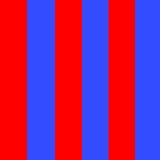
Chromostereopsis
Encyclopedia
Chromostereopsis is a visual illusion
whereby the impression of depth
is perceived in two-dimensional color
images usually red-blue or red-green colors but can also be perceived with red-grey or blue-grey images. Such illusions have been reported for over a century and have generally been attributed to some form of chromatic aberration
. Chromatic aberration results from the fact that coloured lights refract differently depending on the colour causing some light rays to converge before others in the eye (longitudinal chromatic aberration or LCA) and to be located on non-corresponding locations of the two eyes during binocular viewing (transverse chromatic aberration or TCA). The usual stimulus for the study of chromostereopsis consists of a target with red and blue regions where the red portion is either perceived in front of the blue, called positive chromostereopsis, or behind the blue, representing negative chromostereopsis . Over the years several models have been proposed to explain this effect which include longitudinal and transverse chromatic aberrations . However, recent work attribute most of the effects to transverse chromatic aberrations. in combination with cortical factors . Faubert has demonstrated that the strength of the effect and some paradoxical observations such as the same colors seen of different depth planes and different colors seen on the same depth plane demonstrate the importance of spatial configuration and brain function in such illusions and argued that some spatial and color patterns in certain species of butterfly may have evolved to generate such illusions and create the impression of protruding eyes to the predators and that some stain glass artists were probably very aware of this effect and using it to generate protruding sometimes called "warm" and "cold" color images.
Illusion
An illusion is a distortion of the senses, revealing how the brain normally organizes and interprets sensory stimulation. While illusions distort reality, they are generally shared by most people....
whereby the impression of depth
Depth
Depth may refer to:* Depth , an important invariant of rings and modules in commutative and homological algebra* Depth in a well, the measurement between two points in an oil well...
is perceived in two-dimensional color
Color
Color or colour is the visual perceptual property corresponding in humans to the categories called red, green, blue and others. Color derives from the spectrum of light interacting in the eye with the spectral sensitivities of the light receptors...
images usually red-blue or red-green colors but can also be perceived with red-grey or blue-grey images. Such illusions have been reported for over a century and have generally been attributed to some form of chromatic aberration
Chromatic aberration
In optics, chromatic aberration is a type of distortion in which there is a failure of a lens to focus all colors to the same convergence point. It occurs because lenses have a different refractive index for different wavelengths of light...
. Chromatic aberration results from the fact that coloured lights refract differently depending on the colour causing some light rays to converge before others in the eye (longitudinal chromatic aberration or LCA) and to be located on non-corresponding locations of the two eyes during binocular viewing (transverse chromatic aberration or TCA). The usual stimulus for the study of chromostereopsis consists of a target with red and blue regions where the red portion is either perceived in front of the blue, called positive chromostereopsis, or behind the blue, representing negative chromostereopsis . Over the years several models have been proposed to explain this effect which include longitudinal and transverse chromatic aberrations . However, recent work attribute most of the effects to transverse chromatic aberrations. in combination with cortical factors . Faubert has demonstrated that the strength of the effect and some paradoxical observations such as the same colors seen of different depth planes and different colors seen on the same depth plane demonstrate the importance of spatial configuration and brain function in such illusions and argued that some spatial and color patterns in certain species of butterfly may have evolved to generate such illusions and create the impression of protruding eyes to the predators and that some stain glass artists were probably very aware of this effect and using it to generate protruding sometimes called "warm" and "cold" color images.

